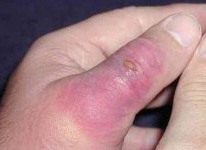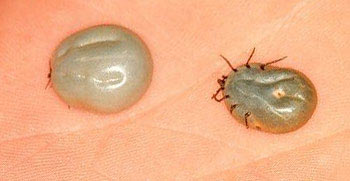




BITES
 |
 |
 |
 |
 |
Introduction
Animal bites and scratches, even minor ones, can become infected and spread bacteria to other parts of the body. Whether the animal is a family pet or a creature from the "wild," scratches and bites can carry disease. For example, cat scratch fever, a bacterial infection, can be transmitted by a cat scratch (usually from a kitten) even if the site of the scratch doesn't look infected. In addition, certain animals can transmit rabies and tetanus. Human bites that break the skin are even more likely to become infected.
What to Do:
If you own a pet, make sure it's properly immunized and licensed.
SPIDER BITES
 |
 |
 |
What is a Brown Recluse Spider
The brown recluse spider is one of a few poisonous kinds of spiders in the United States. It is part of the arachnid family, which includes not just spiders, but ticks, mites, and scorpions too. It has long, skinny legs and is about one-half inch long overall. Its entire body is brown, except for a dark mark in the shape of a violin on its head. Its poisonous relatives may be gray, orange, reddish-brown, or pale brown.
Brown recluse spiders are most commonly found in Midwestern and Southern states of the United States, and they usually hang out in dark places. When they are outside, they like to spend time in piles of rocks, wood, or leaves. If they come inside, brown recluse spiders will go to dark closets, attics, or basements. They aren't aggressive, and they bite only when disturbed.
What a Brown Recluse Spider Bite Looks and Feels Like
A person who gets bitten by a brown recluse spider may not notice anything at first or only feel a little sting at first. After about four to eight hours, the sting will start to hurt a little more. It might look like a bruise or might form a blister surrounded by a bluish-purple area that turns black or brown and becomes crusty after a few days.
What You Should Do
If you ever think that you've been bitten by a brown recluse spider, tell an adult immediately. Brown recluse spider bites rarely kill people, but it's important to get medical attention as soon as you can because they can make you pretty sick. With an adult's help, wash the bite well with soap and water. You can also apply ice to the area, elevate it, and keep it still.
If it's possible, have an adult catch and bring the spider to the doctor's office with you - this is important because it can sometimes be hard to diagnose a spider bite correctly. The spider can be killed first before you bring it with you; just be sure not to squish it so much that no one can tell what it is.
What a Doctor Will Do
Doctors treat people who have been bitten by a brown recluse spider with different types of medications like antibiotics, antihistamines, and pain medicines. Rarely, a skin graft might be needed if the skin is really damaged at the area of the bite. (A skin graft is when a small amount of skin is removed from some part of the body and put in a place where skin is damaged to create new skin.)
How to Avoid Getting Bitten
The best way to avoid getting bitten by brown recluse spiders is to be careful in areas where they like to spend time. Don't play around in rock piles or wood piles. If you are working outside in the yard in big piles of logs or leaves, wear gloves. Be sure to shake out blankets and clothing that have been stored in the attic or the basement, or if they have been in a closet but not used for a long time. If you keep your shoes in a mudroom or garage, shake them out before putting them on.
The two greatest risks from most insect stings and bites are allergic reaction (which may occasionally be fatal) and infection (more likely and less serious).
What to Do:
Spider Bites
Most spiders found in the United States are harmless, with the exception of the black widow and the brown recluse (or violin) spider. Both of these are found in warm climates.
In the southwest United States, an unidentified bite may be caused by a scorpion. Take your child to the emergency room immediately.
TICK BITES
 |
Engorged Tick on Head |
Lymes Rash |
Introduction
Check your children and pets for ticks carefully after you've been in or around a wooded area. Common types of ticks include dog ticks and deer ticks (deer ticks may be carriers of Lyme disease).
If you find a tick on your child:
Disclaimer: This information is not intended be a substitute for professional medical advice. It is provided for educational purposes only. You assume full responsibility for how you choose to use this information.
Updated and reviewed by: Elana Pearl Ben-Joseph, MD
Date reviewed: July 2004, September 2004
Originally reviewed by: Steven Dowshen, MD